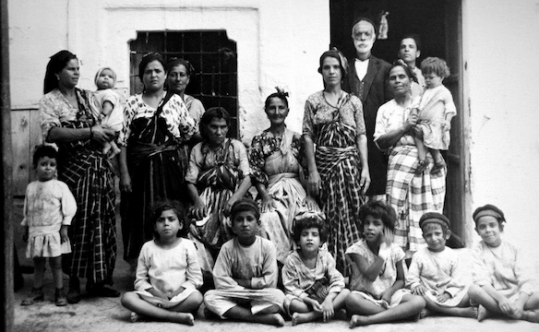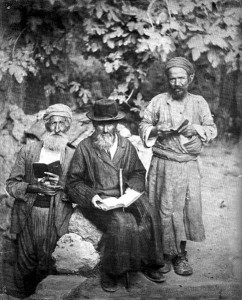The Jewish people have survived numerous atrocities, from slavery in Egypt, to the Spanish Inquisition, to the Farhud in Iraq and the Holocaust. This history of struggle shows that it is necessary to stand up against hatred and evil.
Jews Indigenous to the Middle East and North Africa (JIMENA) is an organization with an important mission. JIMENA raises awareness of the plight of Jewish refugees and other minorities of Sephardic and Mizrahi origin. This past April, a JIMENA representative spoke to students at a University of Southern California event hosted by CAMERA-supported group, SC Students for Israel. The event, “Erev Edot” or “night of nations” in Hebrew, was a multicultural program that encouraged students to reflect on their ancestry and learn about the heritage of others Jews.
JIMENA’s presentation at the event was very important—in general, the Ashkenazi Jewish narrative is more commonly known, especially among American Jews.
Just as the USC students learned at Erev Edot, here are the main reasons why it is important to educate yourself about Middle Eastern and African Jewish history:
1. Recognition of human suffering is a fundamental of human morality
Recognizing human plight within the different branches of our people, let alone throughout the nations of the world, is a necessity as moral human beings. The late Holocaust survivor and human rights activist, Elie Wiesel, would promote the importance of recognizing human suffering:
As long as one dissident is in prison, our freedom will not be true. As long as one child is hungry, our lives will be filled with anguish and shame. What all these victims need above all is to know that they are not alone.

United Nations High Commissioner for Refugees (UNHCR) ruled that Jews fleeing Arab countries were bona fide refugees. Aside from recognizing them as refugees, the world has barely reacted to the hardships of the nearly one million Jews who, since 1948, have been displaced from Arab countries.
The lack of international response on this matter is a reminder for Jews to look out for their own people. Therefore, it is essential to be aware of and informed regarding Middle Eastern and African Jewish atrocities.
2. A true Israel advocate must be a Jewish advocate first

Every Jew who wants to advocate for Israel must know about Sephardic and Mizrahi Jews. If an Ashkenazi Jew, for example, wants to be able to claim a right in Israel as his homeland and call himself indigenous to the land, he must realize that this indigenousness is strongly rooted in the Middle-Eastern branches of the Jewish people.
While Ashkenazi Jews settled into European shtetl’s and spread out across the world, Middle Eastern and North African Jews only settled further into the Israeli region. The Sephardic, Mizrahi Jews’ continuing 2,500-year presence in the Middle East is fundamental for the Jewish people’s right to the land of Israel. So to preach for Israel, an advocate owes it to his Middle Eastern and North African Jewish brothers to preach for them as well.
3. Embracing diversity within the Jewish people is unifying

Knowing more about all kinds of Jews enriches one’s Jewish identity and unifies the Jewish people as a whole. In addition, studying Sephardic and Mizrahi Jewry helps to balance and preserve the accuracy of their historical narrative.
This past March, Israeli Education Minister Naftali Bennett addressed the need to teach the entire Jewish narrative. He argued that not including Mizrahi, Sephardic Jews in education curriculums is unacceptable. The complete Jewish story is comprised of many stories of different kinds of Jews which now will all be taught in Israeli schools.
4. Their story is every Jew’s story
The Middle Eastern and African experience is a part of every Jew’s narrative—the Ashkenazi history is very much interconnected with the Sephardic history.
While Nazism spread throughout Europe, it also reached parts of the Middle East and North Africa during the 1930’s. Hitler once met with another enemy of the Jewish people, Palestinian Arab nationalist leader Haj Amin al-Husseini. Husseini supported Hitler and the evils of Nazism. Just as Hitler called to annihilate Jews, Husseini broadcasted to the Arab World to “Rise as one man and fight for your sacred rights. Kill the Jews wherever you find them.”

While Nazism took control, Arab Nationalism gained power over Jews and subjected them to severe mistreatment and abuse. After Israel was established in 1948, many Jews could make it to Israel but the plight of Middle Eastern Jews continued—Arab countries turned hostile to their own Jewish populations, making life intolerable for them.
5. Their rich culture has so much to offer the entire Jewish people

Aside from the moral reasons to be aware about Middle Eastern and African Jewry, it is a cultural loss to not learn about the Sephardic, Mizrahi narrative. Between Henna ceremonies, Ladino music, Iranian cuisine, their rich culture has so much to offer to all Jews. JIMENA works hard to preserve and bring this wonderful heritage fully back to life.
As a people that have survived and overcome tremendous suffering, the Jews should recognize the internal struggles of their own people. As a respect to their ancestors who suffered, Jews have an obligation to take initiative and learn about their people’s troubles as well as the world’s. By recognizing human plight, a person can then strive to contribute to his fellow man and help to repair the world.
Contributed by CAMERA Intern Penina Simkovitz
